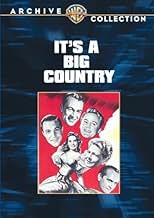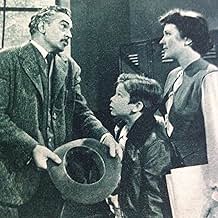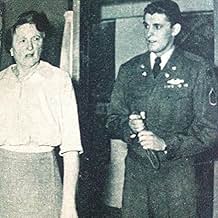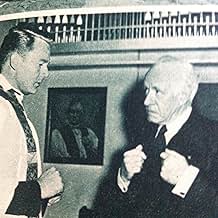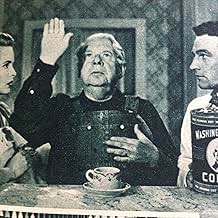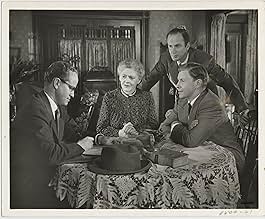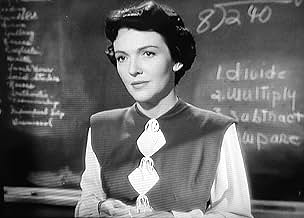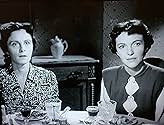Añade un argumento en tu idiomaComprised of eight unrelated episodes of inconsistent quality, this anthology piece of American propaganda features some of MGM Studios' best directors, screenwriters and actors; it is narra... Leer todoComprised of eight unrelated episodes of inconsistent quality, this anthology piece of American propaganda features some of MGM Studios' best directors, screenwriters and actors; it is narrated by Louis Calhern.Comprised of eight unrelated episodes of inconsistent quality, this anthology piece of American propaganda features some of MGM Studios' best directors, screenwriters and actors; it is narrated by Louis Calhern.
- Miss Coleman
- (as Nancy Davis)
- Joey Esposito
- (as Bobby Hyatt)
Reseñas destacadas
I had thought that the "episodic" film format was an invention of the 1980's art film. "It's a Big Country" killed that myth by presenting a film about the USA that is built on eight different episodes. The episodes are drawn together by a common narration, their focus on different ways of looking at the USA, and the introductory episode which lays out the concept for the film.
In the opening segment, James Whitmore rides a commuter train and tells another rider, "I love this country?" The other rider's response catches Whitmore off guard. "Which country?" He then points out that the USA is many countries -- political, military, religious, industrious, urban, rural, and many others. Each of the following seven segments of the film then focus on various ways of looking at the USA.
The actors in those seven segments are a "Who's Who" of 1950's film. The already mentioned Whitmore, Gene Kelly, Van Johnson, Gary Cooper, Janet Leigh and Keenan Wynn share the screen along with many others, including legends Ethel Barrymore and Fredric March. If you are a classic film lover, check out the list of credits and you'll find at least one favorite among the actors.
The film overall only comes across as average however -- it seems rather "preachy" on the concept of acceptance, and the happy endings of the segments come across too sugary. Fortunately the great acting in some of the segments pull them to the top of the heap. Gary Cooper's deadpan delivery combined with his Texas drawl in the one true comedy segment work's well. And the final segment in which a young immigrant boy finds he must wear glasses at the risk of ridicule of his father as well as his friends at school is equally appealing.
There is one glaring inconsistency in the film. The overall point seems to be that we must drop our racial stereotypes. To that end virtually every racial stereotype is presented and cut down. Each of the episodes of the film is presented as independent stories within the film -- little stories within the story. But when they presented the segment focusing on African American's, no story is given, only a narrated segment with stock shots of black America are presented. Not one known American actor of African descent is included. In this respect, Hollywood seems to have been unable to overcome it's own prejudice and exclusionary practices of that time.
You might enjoy portions of this film, but most persons will either stop part way through or fall asleep during this average film.
Directed by seven different directors and featuring an ensemble cast of both MGM contract actors and non contract players, this film portrays various stories and characters, each representing different aspects of American life as it existed in the 1950s. I won't go over every segment, but I will mention some that stood out and why.
In the segment concerning the Hungarian immigrant (S. Z. Sakall) who does not want his daughter to marry a Greek because Hungarians hate Greeks - Is that even true?
The third segment is different from the rest as it is a mini documentary concerning successful and prominent Black Americans. This is actually the best part of the film as it was very informative and progressive for its time.
The fifth segment about a Jewish soldier who has been to Korea visiting the mother of a dead comrade in arms seems like it might have originally been written concerning WWII soldiers.
The sixth segment has Gary Cooper as a Texan disputing Texas stereotypes by dispensing even more Texas stereotypes. Qualifications for this judgment - I am a Texan.
The seventh segment also seems like it might have been written for WWII. Van Johnson plays the minister in a church that the president attends when in Washington, and as a result he writes a bunch of dull wonky sermons about public policy that only the president could appreciate. The reason that I think that it was written for WWII is that Lewis Stone talks about how the president was missing if traveling or relaxing at Hyde Park, which is where Roosevelt lived. Also, at the end, when the president is going to come see Johnson's character, there is the distinct sound of crutches.
I liked the introductory segment the best because it had William Powell in it AND it had Powell, as a passenger on a train who puts an annoying know it all in his place. Powell is actually the reason I decided to watch this in the first place.
I would say the film as a whole is a tough slog unless you look at it in its historical context.
Wellmann and co tell us that America is a big country ,with big differences but where everybody has his place in the sun: in the "celebrities" segment,there are plenty of black artists such as Armstrong ,but the civil rights were ignored in 1949.
What saves this naive film containing more finer feelings than a Capra movie,is some kind of humor .Take the first scene on a train and the last sentence of the baffled traveler or the Hungarian daddy who does not want his daughters to marry a Greek,cause we are "enemies" .How great the melting pot is!And so are Gene Kelly and Janet Leigh.
Some stars only appear a few minutes:Gary Cooper tells us what a wonderful state "Lone Star" Texas is where oil spurts out everywhere under your feet;Ethel Barrymore plays a delightful old lady who is cross cause she was not counted when they took a census of the population.
The last sketch ,about glasses ,was perhaps not a very good choice to conclude the movie.
It was,is and will always be a big country.
It's a film with several different segments, some serious some pretty funny about every day Americans in all walks of life, in all parts of the then 48 states.
The two I liked best were those that ironically starred the two men who were not MGM contract players, Gary Cooper and Fredric March. Gary Cooper plays a Texas cowboy talking about his state and disillusioning us with a tongue in cheek delivery about the way Texans and Texas are perceived by the other 47 states. Of course Cooper's humor and the whole premise behind this segment was that Texas was our largest state in land mass. That ended in 1959 when Alaska became the 49th state, still it's the highlight of It's A Big Country.
Fredric March plays an Italian American father who's opposed to his son, Bobby Hyatt, getting needed glasses even after teacher Nancy Davis tells him it's necessary. He's got some old world ideas that need a bit of adjustment. March plays the role with dignity never do you feel he's a caricature.
Another episode that is nicely done involves Gene Kelly, Greek American boy falling for Janet Leigh, Hungarian American girl. They've got a problem though, her father played by Hollywood's number one Hungarian S.Z. Sakall. In the past 20 years we've seen a whole lot of stories about ancient ethnic hatreds coming out of Eastern Europe. Sakall is carrying some old grudges against Greeks though he really isn't sure why. Point being that here in America you're supposed to leave that all behind. That segment is still very much relevant.
Could we make It's A Big Country today? Not at this time, maybe at some future point when we've reached a national consensus that despite all our problems, America's a pretty good place after all.
An opening segment on a train, that draws us into the whole thing, features James Whitmore as a patriotic, "I love America" type. "Which America?" asks the always-debonair and well-spoken William Powell. We then see the many sides of our country depicted through vignettes.
There are a couple of segments against prejudice. One is about a Greek-hating Hungarian American father of several girls (S. Z. Sakall) whose eldest daughter (Janet Leigh) falls for a young Greek American (Gene Kelly - actually pushing 40 at the time but you'd never guess it). As a piece against xenophobia, it's nice, and gets its point across with humor, wit, and romance.
There's also a segment against religious prejudice, where an ex-seviceman named Maxie Klein (Keefe Brasselle) visits the mother (Marjorie Main) of a dead war buddy. At first the mother doesn't know the man because her son had used his nickname in his letters. She's suspicious of his motives because he's Jewish. Eventually she's grateful for the comfort the stranger has given her, putting aside whatever prejudices she was harboring, and requesting his mother's address so that she can write her about it all.
The segments are all fairly interesting, but not exactly first-rate drama or comedy.
There's one about a minister (Van Johnson) who learns a lesson in humility from a deacon (played by Louis Stone). There's one in which Fredric March plays a working-class Italian American who won't be convinced by a schoolteacher (Nancy Davis) his son needs glasses. Gary Cooper plays a cowboy in a humorous monologue about Texas. Louis Calhern narrates a documentary sequence about African Americans. Ethel Barrymore and George Murphy star in a dramatic sketch wherein an old Boston-Irish woman is upset because the US Census ignored her. Etc.
The overall effect is a little like picking up an old copy of Reader's Digest.
Without the stars, this would be very minor, indeed. With them, it becomes a big film. Not a great film, but, undoubtedly, a big one. It covers a lot of ground, and comes up a little bit short.
¿Sabías que...?
- CuriosidadesWhen she discovers that Icarus Xenophon (Gene Kelly) is Greek, Janet Leigh does a spot-on imitation of S.Z. "Cuddles" Sakall's (S.Z. Sakall) trademark response to upsetting news, placing her palms against her cheeks and emitting an exasperated "Sheeeesh!"
- PifiasWhen the census taker asks Ethel Barrymore her name, she replies "Mrs. Brian Patrick Riordan" and he writes it down. Always with censuses, a woman's given name is entered.
- Citas
Rosa Szabo Xenophon: Marry me? You don't know anything about me.
Icarus Xenophon: You're a girl. You're pretty and you're modest. What else is there to know?
- ConexionesEdited into A Letter from a Soldier (1951)
Selecciones populares
- How long is It's a Big Country: An American Anthology?Con tecnología de Alexa
Detalles
- Fecha de lanzamiento
- País de origen
- Idiomas
- Títulos en diferentes países
- Nueve vidas
- Localizaciones del rodaje
- 1772 Church Street NW, Washington, Columbia, Estados Unidos(St. Thomas Episcopal Church - where Rev. Birch was assigned)
- Empresa productora
- Ver más compañías en los créditos en IMDbPro
Taquilla
- Presupuesto
- 1.013.000 US$ (estimación)
- Duración1 hora 29 minutos
- Color
- Relación de aspecto
- 1.37 : 1
Contribuir a esta página


